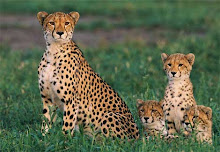Leopard
Leopards" redirects here. For other uses, see Leopards (disambiguation).
Leopard[1]Fossil range: Late Pliocene or Early Pleistocene to Recent
Conservation status
Near Threatened (IUCN 3.1)[2]
Scientific classification
Kingdom:
Animalia
Phylum:
Chordata
Class:
Mammalia
Order:
Carnivora
Family:
Felidae
Genus:
Panthera
Species:
P. pardus
Binomial name
Panthera pardusLinnaeus, 1758
The leopard (IPA /lɛpə(r)d/; Panthera pardus) is a member of the Felidae family and the smallest of the four "big cats" in the genus Panthera; the other three are the tiger, lion and jaguar. Once distributed across southern Asia and Africa, from Korea to South Africa, the leopard's range of distribution has decreased radically over time due to hunting and loss of habitat, and the leopard now chiefly occurs in sub-Saharan Africa. There are fragmented populations in India, Indochina, Malaysia, and China. Due to the loss of range and continual declines in population, the cat has been downgraded to "Near Threatened" species; its numbers are greater than that of the other Panthera species, all of which face more acute conservation concerns. [2]
The leopard has relatively short legs and a long body, with a large skull. Physically, it most closely resembles the jaguar, although it is usually smaller and of slighter build. Its fur is marked with rosettes which lack internal spots, unlike those of the jaguar. Leopards that are melanistic, either completely black or very dark in coloration, are one of the big cats known colloquially as black panthers.
The species' success in the wild owes in part to its opportunistic hunting behaviour, its adaptability to a variety of habitats and its ability to move at up to approximately 60 kilometres (37 miles) an hour. The leopard consumes virtually any animal it can hunt down and catch. Its preferred habitat ranges from rainforest to desert terrains. Its ecological role and status resembles that of the similarly-sized cougar in the Americas.
KEMENTERIAN KESIHATAN MASIH BELUM MAMPU MENJELASKAN BAGAIMANAKAH SAMPEL
COKLAT DIUJI DICEMARI DNA BABI
-
Saya siarkan temu bual wartawan Utusan Malaysia bersama Ketua Pengarah
Kementerian Kesihatan Malaysia, KKM, Datuk Noor Hisham Abdullah.
UTUSAN : Mengapa...
11 years ago



No comments:
Post a Comment